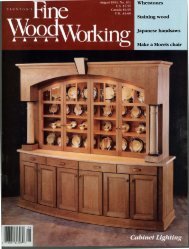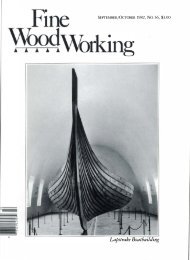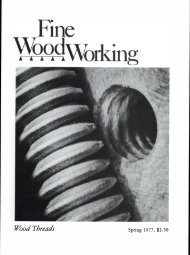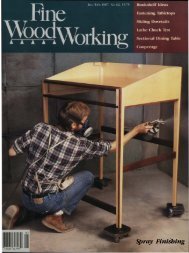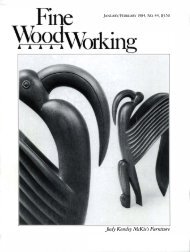NOVEMBER/DECEMBER 1983, No. 43, $3.50 Making ... - Wood Tools
NOVEMBER/DECEMBER 1983, No. 43, $3.50 Making ... - Wood Tools
NOVEMBER/DECEMBER 1983, No. 43, $3.50 Making ... - Wood Tools
You also want an ePaper? Increase the reach of your titles
YUMPU automatically turns print PDFs into web optimized ePapers that Google loves.
Miters, tape and glue<br />
I use ordinary masking tape to clamp up<br />
a bookmatched panel for the lid or bottOm<br />
of one of my little boxes. To glue<br />
up a box's mitered corners, I supplement<br />
the tape with rubber bands.<br />
Before gluing up a matched panel,<br />
sand, plane or joint the good side of<br />
both pieces so that you can see the final<br />
figure. Then hold the pieces tOgether in<br />
front of a window or a bright light, to<br />
make sure the gluing surfaces meet exactly.<br />
If they don't, plane them until no<br />
light shows through anywhere. You<br />
don't have to fret about square edges if<br />
you fold the bookmatch good-side-in,<br />
clamp the pair of boards in the vise and<br />
plane both edges at the same time. If<br />
you machine-joint, you'll get the cleanest<br />
glueline by skimming off the mill<br />
marks with a pass of the hand plane.<br />
Both pieces of wood ought to end up<br />
the same thickness,<br />
tape<br />
but if at this stage<br />
they aren't, you'll have to take care that<br />
the good side glues up flat, with the irregularities<br />
on the back side only. To do<br />
so, lay the pieces on the bench goodside-up,<br />
and line up the figure. Run a<br />
piece of masking across the joint line<br />
to keep the figure from shifting. Next,<br />
lightly apply a strip of tape along the<br />
full length of the joint and flip the as-<br />
34<br />
Fig. A: Miter-gauge shim<br />
<strong>No</strong>tch lets<br />
'A-in . plastic<br />
shim work as<br />
push stick. �<br />
' Push to align<br />
miter gauge<br />
against saw<br />
table 's edge . .<br />
Fig . . C: Ta ping the mite..rs<br />
Fig. D: Jig for tablesawing cross-spline slots<br />
sembly over. From the back, press along<br />
the joint to stick the tape down firmly.<br />
Bend the joint open and apply glue.<br />
Yellow Titebond, as it comes from the<br />
jug, is formulated for filling gaps and<br />
thus is thicker than it needs to be for<br />
long-grain gluing. If your joint is lighttight,<br />
such a thick glue will leave a visible<br />
glueline. If you thin a tablespoonful<br />
of the glue by adding a few drops of<br />
water, it will hold better, and the joint<br />
will be invisible. To clamp the joint, run<br />
a short piece of tape opposite the first<br />
one, then similarly tape every 2 in. or so<br />
across the joint, taking care to balance<br />
the tension on both sides of the panel as<br />
you go, else it will curl. You should not<br />
need ro weight the panel flat.<br />
Miters for box sides are best cut with<br />
the wood flat on the saw table, with the<br />
blade tilted to 450 and the gauge set at<br />
900 to the blade. I used to set the miter<br />
gauge with the aid of a carpenters'<br />
square, but a reader, Dustin Davis of<br />
Frostburg, Md., sent in a simple device<br />
(figure A) that makes the<br />
-<br />
job much<br />
easier. It's a shim of X-in. plastic that<br />
allows you to register the face of the<br />
miter gauge against the front edge of<br />
the saw table, which on most saws is accurately<br />
machined at 900 to the slots in<br />
o 2. 1. Fig. B: Checking 45° angles<br />
Miter-crosscut.<br />
Recut offcu� piece.<br />
,-..: : __.'<br />
4. Adjust cut. until miters fit straight. �-



